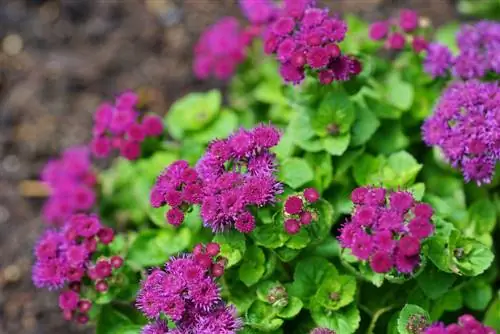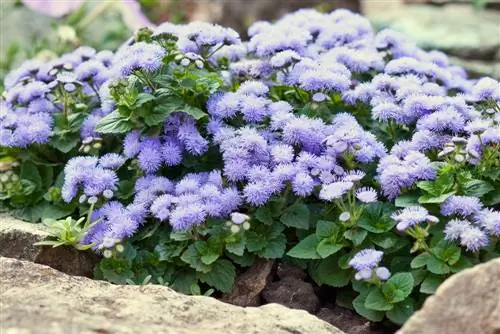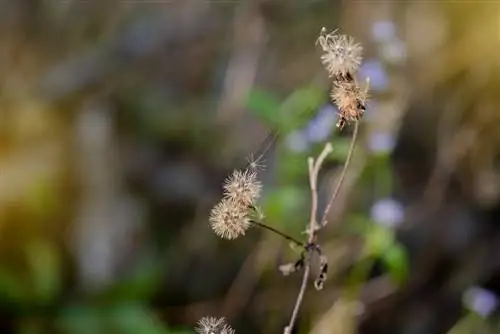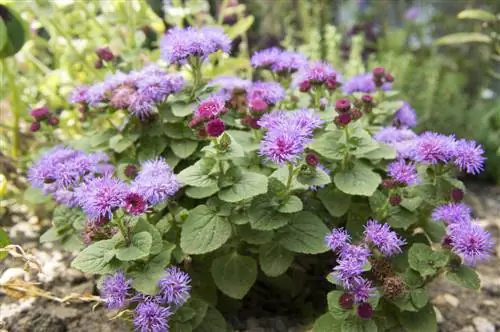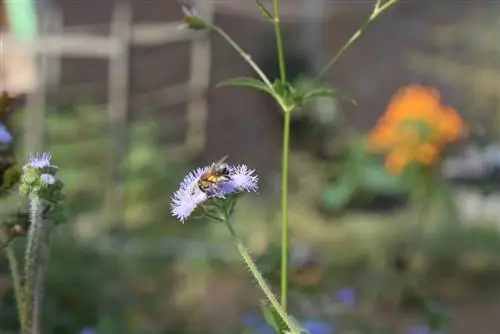- Author admin [email protected].
- Public 2023-12-16 16:46.
- Last modified 2025-01-23 11:21.
Whether in the bed, as a border or in the balcony box: the liver balm is a versatile ornamental plant. The semi-shrub or dwarf shrub is particularly valued because of its colorful, long-lasting colors. The tubular flowers, arranged in clusters, appear in bright blue, but also in white, purple, pink or red.

What is liver balm and where is it used?
Liver Balsam is a colorful, versatile ornamental plant that originally comes from Mexico. With a growth height of 30-60 cm, it is suitable for beds, balcony boxes and borders. Dense clusters of blue, white, purple, pink or red flowers appear between May and October.
Origin and distribution
Liver balm (bot. Ageratum houstonianum or A. mexicanum) originally comes from Mexico, where it occurs wild in moist, forested or bushy regions as well as in meadows and pastures at altitudes of up to 1000 meters. The pretty, warmth-loving plant can also be found in Guatemala, Belize and the south of the USA. In its tropical to subtropical homeland, liver balm, which belongs to the daisy family (Asteraceae), is a perennial plant, but is generally only cultivated as an annual here.
Usage
The purpose of liver balm depends largely on its height. Low and compact growing varieties look particularly pretty in balcony boxes and as borders or under planting in beds and borders. They are also often suitable as perennially flowering ground cover plants that cleverly cover the lower bare areas in perennial and shrub borders or serve as gap fillers. Higher varieties are also very suitable for group planting, with the typically blue-violet flowers particularly in combination with yellow-flowering marigolds and marigolds (calendula), but also with verbena, sun eyes, rudbeckia or coreopsis (girl's eye). Grove flowers (Nemophila), snapdragons (Antirrhinum majus), lady's bell flowers (Campanula medium) and ornamental tobacco (e.g. Nicotiana x sanderae) are also attractive companions.
Furthermore, taller growth forms of the liver balsam (for example the blue-flowering 'Schnitwunder') are popular cut flowers for the vase.
Appearance and growth
Botanically speaking, liver balsam is a semi- or dwarf shrub that only grows to a height of between 30 and 60 centimeters and is woody in the lower stem area. Most varieties grow rather compactly and form dense cushions. The leaves, which are between five and seven centimeters long, are slightly downy and have a pretty heart shape. The leaf margin is typically notched or wavy.
Flowers and flowering time
The fine flower heads, only up to 14 millimeters in size, are extremely numerous between May and October and form dense clusters with up to 40 individual tubular flowers. The short-stemmed flowers sit directly above the leaves and are usually blue, blue-violet or violet in color. But there are also white, pink and even purple cultivars that bring variety to the flower bed. Once the flowers have bloomed, tiny, inconspicuous achenes (closed fruits) form that contain numerous seeds.
Toxicity
All parts of the liver balm plant are poisonous and, if consumed, can trigger typical symptoms of poisoning such as headaches, dizziness and nausea, as well as cramps, vomiting and diarrhea. Neither leaves nor flowers (or other parts) may be used in meals, no matter how attractive they look. Furthermore, children and pets must be kept away from the plants.
Which location is suitable?
So that the liver balm grows he althy and strong and produces numerous flowers, it needs a location that is as sunny and warm as possible. As long as it receives at least five hours of direct sunlight every day, you can also place it in partial shade. The flower only produces flowers when there is sufficient brightness. However, it is quite insensitive to rain and wind.
Soil /Substrate
The liver balsam only develops its magnificent abundance of flowers in the right soil. This should be nutrient-rich, humic and well-drained. The plant thrives particularly well in loamy, loose and fresh soil. The ideal pH is neutral to slightly acidic between 5.5 and 6.6. It is best to plant liver balm cultivated in pots in high-quality compost-based potting soil or standard soil (€10.00 on Amazon). Make sure there is good drainage in both the garden bed and the planter, for example using gravel or expanded clay, because the liver balm is very sensitive to waterlogging.
Planting
For particularly compact and dense growth, you should plant liver balsam in groups of five in the bed. Loosen the planting area well and dig planting holes at regular intervals. These should be approximately twice as large as the roots of the plants. Mix the excavated material with compost, horn shavings and, if necessary, sand to loosen up heavy soils.
Planting time
Since liver balm has its home in the warm climes of this planet, it cannot tolerate frost. Therefore, only plant it after the Ice Saints, as soon as night frosts are no longer expected. However, you can prefer the plant in pots on the windowsill.
Planting spacing
The optimal planting distance depends on the variety chosen and is between ten and 40 centimeters.
Pour liver balm
With regard to the optimal water supply, the liver balm needs a lot of attention, as it only produces a few flowers if it is insufficiently supplied. Therefore, water the plant regularly, which is particularly important in dry locations, hot weather and well-drained soils. At the same time, however, the liver balm is also sensitive to waterlogging, which is why good drainage must be ensured, especially for potted plants. Don't let the plant dry out, but don't flood it either.
Fertilize liver balm properly
In addition to a sufficient supply of water, liver balm also needs an appropriate supply of nutrients for lush flowering. Fertilize potted plants about every two to four weeks with a liquid fertilizer for flowering plants, which you administer with the irrigation water. Liver Balsam in the bed is supplied with a suitable long-term fertilizer when planting, but you can also mix compost and horn shavings into the excavation and then mulch the plants with ripe compost.
Cut liver balm correctly
So that the liver balm's flowering period is extended as long as possible, you should regularly remove dead shoots. If this does not happen, the plant produces seed-containing fruit and stops flowering prematurely. However, you can leave individual shoots standing to collect seeds.
Propagate Liver Balm
You can easily sow and grow liver balm yourself on the windowsill from February onwards. And this is how it works:
- Fill a growing tray with low-nutrient growing substrate mixed with sand.
- Spread the seeds onto the substrate and press them lightly.
- However, do not cover the seed with soil as it is a light germinator.
- Wet the substrate using a spray bottle.
- Cover the seed tray with cling film or a translucent hood.
- Place the container in a light and warm place at at least 20 °C.
- In the first few days, the container should be kept as warm as possible at at least 25 to 28 °C.
- Air daily and always keep the substrate slightly moist.
The first seedlings appear after just a few weeks and can be pricked out after around four weeks and planted in groups of three in small pots (at least nine centimeters in diameter). Keep the young plants warm at temperatures between 16 and 20 °C and bright, but not directly sunny. After the ice saints, plant the liver balm outdoors, either in the garden bed or on the balcony. Beforehand, slowly get the plants used to the brighter location.
Alternatively, propagation via cuttings is also possible, but is rarely practiced due to the difficulty of overwintering liver balm.
Wintering
Since our liver balm is not frost hardy, it is usually not kept over the winter. The easiest way is to only cultivate the small bushes as an annual and to sow them again every spring.
Diseases and pests
The main problem with liver balm is excessive moisture or even waterlogging, which soon becomes apparent through missing or browning flowers, brown leaves and general signs of wilting. To avoid this, good drainage is extremely important both in the bed and in the pot. However, brown leaves often indicate a pest infestation, with leaflets, spider mites and aphids being particularly common. Strengthen the plants and prevent infestation by watering bedding plants with nettle broth from time to time. This also provides additional valuable nutrients. In addition, brown or otherwise diseased plant parts must be removed as quickly as possible.
Tip
If the leaves of the liver balm appear speckled, there is usually no fungal disease behind it. Instead, the plant develops such symptoms when it is too cold or when it is too dark. In this case, transplanting to a sunnier location will help.
Species and varieties
Numerous different varieties of liver balm are available commercially, either as an F1 hybrid or as a seed version. Only from the latter can you collect the seeds and use them for re-sowing. These varieties are particularly suitable for the garden and balcony:
- 'Arielle Blue': growth height between 20 and 30 centimeters, blue-violet flowers
- 'Blue Danube': grows to a height of approx. 20 centimeters, medium blue flowers
- ‘Blue Fields’: low growth, dark blue flowers
- 'Capri': height between 20 and 30 centimeters, blue-violet flowers
- 'Madison': low growth, medium blue flowers
- 'Old Grey': growth height up to approx. 50 centimeters, gray-blue flowers
- 'Pacific': low growth, bright purple-violet flowers
- ‘Royal Hawaii’: low growth, dark blue flowers
- 'Cut Pearl': between 50 and 70 centimeters high, large, dark blue flowers
- 'Cut wonder': between 50 and 80 centimeters high, deep blue flowers
- 'White cut': growth height up to approx. 60 centimeters, pure white flowers
- ‘White Hawaii’: low growth, white flowers
In addition, there are native perennials with similar names that are also well suited for garden planting. However, these sometimes have different requirements in terms of location and care:
- Liverwort (Hepatica nobilis): low growth up to 15 centimeters high, blue-violet flowers, perennial, hardy, for semi-shady to shady locations
- Alpine liver balsam (Erinus alpinus): also Alpine balsam, low growth up to 20 centimeters high, cushion-forming, red, pink or white flowers, for dry and sunny locations
Similarly pretty blue flowers, but also perennial and more robust than liver balsam, is the small periwinkle (Vinca minor), which blooms persistently between April and September, quickly covers the ground with a dense carpet and is also perennial and hardy.

